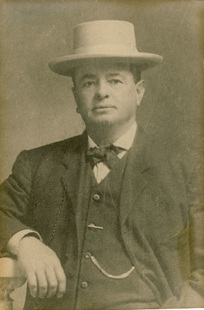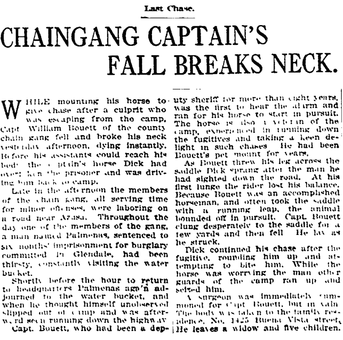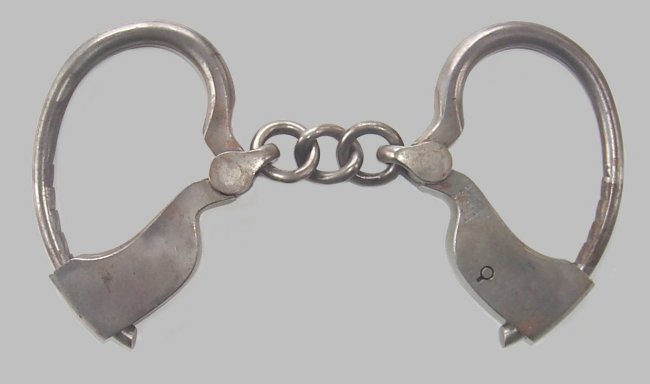The Untimely Death of Guillermo Bouett (1857–1913)
Guillermo Bouett, sixth child and third son of French immigrant Jean Bouet and his wife, María Loreta Cota, was born in October, 1857 in Los Angeles. He married María Agustina Solano, daughter of Solano Canyon founder Francisco Solano and his wife, Rosa Casanova, on February 15, 1881 in the Plaza Church, and he was killed near Azusa on February 18, 1913 while on duty as the Captain of a chain gang in the Los Angeles County Sheriff's Department.
 Guillermo Bouett, ca 1890
Guillermo Bouett, ca 1890
This is the story of his untimely death.
Guillermo Bouett, or William, as he was known, worked at many different jobs over the years for which we have a record of him. In the 1878 Los Angeles City Directory, the first year for which we have any information about his occupations, hes was described as 'Apprentice'. In the 1880 census, his occupation was given as 'works in Planing Mill'. The mill was probably the Perry Mill and Lumber Company; his younger brother, Agustín José, was an engineer for the mill for many years. By 1883, he was a 'workman at Perry & Woodworth's'; 1884 has him as a 'Sash-maker, W. H. Perry Lumber and Mill Co.' The year 1887 found him as a 'Machinist' for the same company. In 1889, he was the pound-keeper at the County Pound, and by 1890, he was a 'Mechanic' at a business that was located at 1017 South Olive Street, but at what business is not known.
He began his law enforcement career by 1891, when he was 'Constable, Los Angeles City Township court', but by 1893, and again in 1894, he was again listed as 'Mechanic'. Then, in 1895, he was a 'Pattern maker'. In 1896, he was 'Carpenter, Kerckhoff-Cuzner M. and L. Co.' and in 1897, 'Machine hand' for the same company. The 1890 City Directory simply said 'Oil' as his occupation, which the census that same year elaborated as 'Oil Dealer', and which the City Directories continued to report through 1903.
He dabbled a bit in politics, being elected to the Los Angeles City convention as a Republican in 1897 and 1905.
In 1904, though, he returned to law enforcement as a guard at the County jail. In 1905, he was listed as a deputy at the same place. The following year, he became a Deputy Sheriff with the County Sheriff's Department. In 1907, he became a Captain of a chain gang, and he remained a Deputy Sheriff until he was killed in 1913.
This article in the Los Angeles Times on February 18, 1913, tells the story best, which is quoted in full below the image..
Guillermo Bouett, or William, as he was known, worked at many different jobs over the years for which we have a record of him. In the 1878 Los Angeles City Directory, the first year for which we have any information about his occupations, hes was described as 'Apprentice'. In the 1880 census, his occupation was given as 'works in Planing Mill'. The mill was probably the Perry Mill and Lumber Company; his younger brother, Agustín José, was an engineer for the mill for many years. By 1883, he was a 'workman at Perry & Woodworth's'; 1884 has him as a 'Sash-maker, W. H. Perry Lumber and Mill Co.' The year 1887 found him as a 'Machinist' for the same company. In 1889, he was the pound-keeper at the County Pound, and by 1890, he was a 'Mechanic' at a business that was located at 1017 South Olive Street, but at what business is not known.
He began his law enforcement career by 1891, when he was 'Constable, Los Angeles City Township court', but by 1893, and again in 1894, he was again listed as 'Mechanic'. Then, in 1895, he was a 'Pattern maker'. In 1896, he was 'Carpenter, Kerckhoff-Cuzner M. and L. Co.' and in 1897, 'Machine hand' for the same company. The 1890 City Directory simply said 'Oil' as his occupation, which the census that same year elaborated as 'Oil Dealer', and which the City Directories continued to report through 1903.
He dabbled a bit in politics, being elected to the Los Angeles City convention as a Republican in 1897 and 1905.
In 1904, though, he returned to law enforcement as a guard at the County jail. In 1905, he was listed as a deputy at the same place. The following year, he became a Deputy Sheriff with the County Sheriff's Department. In 1907, he became a Captain of a chain gang, and he remained a Deputy Sheriff until he was killed in 1913.
This article in the Los Angeles Times on February 18, 1913, tells the story best, which is quoted in full below the image..
Los Angeles Times, Wednesday, February 19, 1913
Last Chase.
CHAINGANG CAPTAIN'S FALL BREAKS NECK.
While mounting his horse to give chase after a culprit who was escaping from the camp, Capt. William Bouett of the county chain gang fell and broke his neck yesterday afternoon, dying instantly. Before his assistants could reach his body, the Captain's horse, Dick, had overtaken the prisoner and was driving him back to camp.
Late in the afternoon the members of the chain gang, all serving time for minor offenses, were laboring on a road near Azusa. Throughout the day one of the members of the gang, a man named Palmenus, sentenced to six months' imprisonment for burglary committed in Glendale, had been thirsty, constantly visiting the water bucket.
Shortly before the hour to return to headquarters Palmenas again adjourned to the water bucket, and when he thought himself unobserved slipped out of camp and was afterward seen running down the highway.
Capt. Bouett, who had been a deputy sheriff for more than eight years, was the first to hear the alarm and ran for his horse to start in pursuit. The horse is also a veteran of the camp, experienced in running down the fugitives and taking a keen delight in such chases. He had been Bouett's pet mount for years.
As Bouett threw his leg across the saddle Dick sprang after the man he had sighted down the road. At his first lunge the rider lost his balance. Because Bouett was an accomplished horseman, and often took the saddle with a running leap, the animal bounded off in pursuit. Capt. Bouett clung desperately to the saddle for a few yards and then fell. He lay as he struck.
Dick continued his chase after the fugitive, rounding him up and attempting to bite him. While the horse was worrying the man other guards of the camp ran up and seized him.
A surgeon was immediately summoned for Capt. Bouett, but in vain. The body was taken to the family residence, No. 1425 Buena Vista street. He leaves a widow and five children.
One might only add to this incredible, and incredibly-detailed, account that the youngest of the five orphans left by Capt. Bouett's untimely death was Teodoro Manuel Bouett, the author's grandfather.
In addition to the original portrait of Guillermo Bouett, above, the author is in possession of his handcuffs, a well-preserved pair of Towers Double-Lock, generally touted as the most secure handcuffs ever made in America; once the double-lock has been set, it is impossible to release, even with a shim. The original cost of the Towers Double-lock Number 10 in the 1904 catalog of the Union Hardware Company was $4.00; a nickel-plated version cost $4.75.
In addition to the original portrait of Guillermo Bouett, above, the author is in possession of his handcuffs, a well-preserved pair of Towers Double-Lock, generally touted as the most secure handcuffs ever made in America; once the double-lock has been set, it is impossible to release, even with a shim. The original cost of the Towers Double-lock Number 10 in the 1904 catalog of the Union Hardware Company was $4.00; a nickel-plated version cost $4.75.



